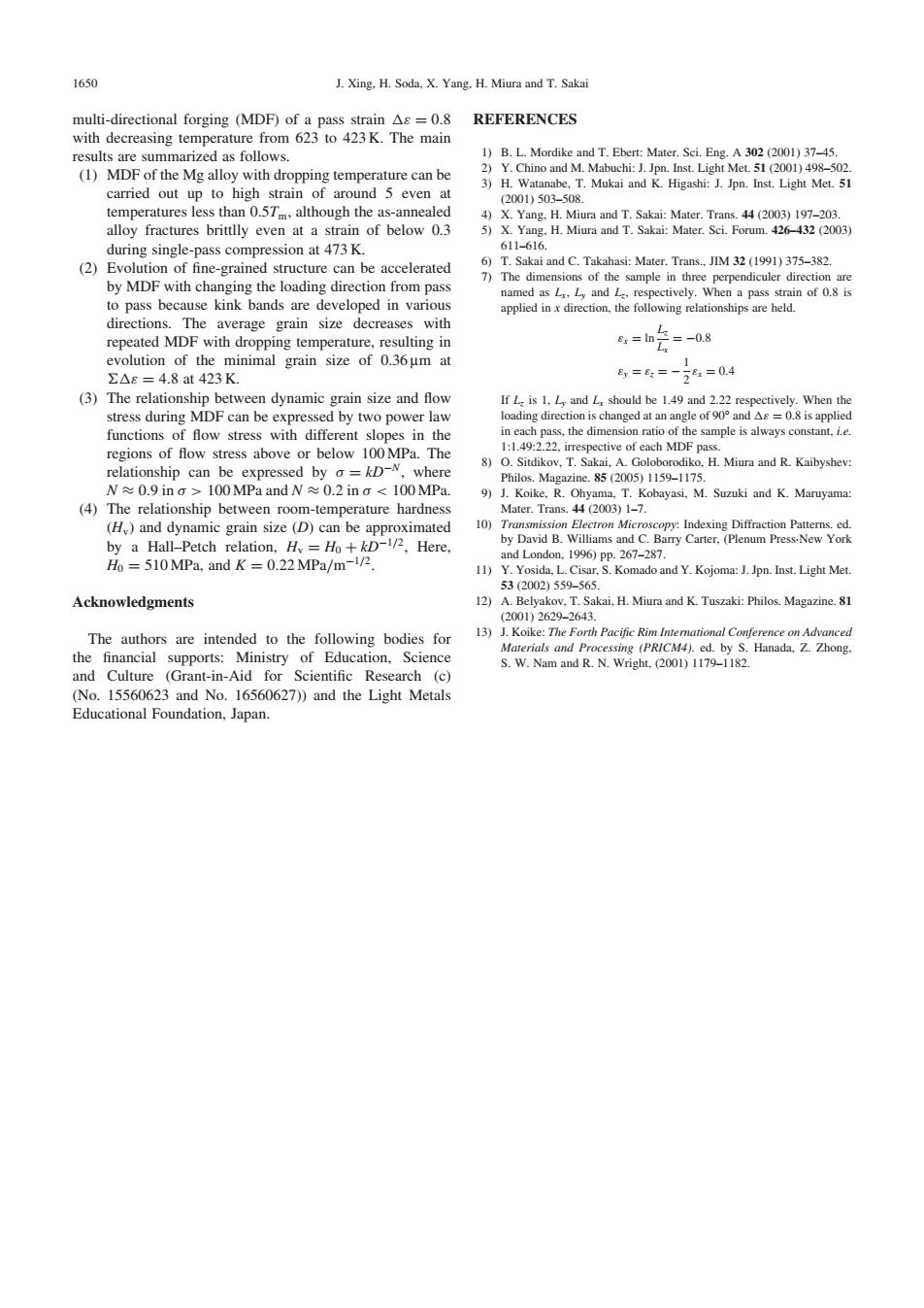正在加载图片...

1650 J.Xing,H.Soda,X.Yang,H.Miura and T.Sakai multi-directional forging (MDF)of a pass strain As=0.8 REFERENCES with decreasing temperature from 623 to 423 K.The main results are summarized as follows. 1)B.L.Mordike and T.Ebert:Mater.Sci.Eng.A 302 (2001)37-45. (1)MDF of the Mg alloy with dropping temperature can be 2)Y.Chino and M.Mabuchi:J.Jpn.Inst.Light Met.51 (2001)498-502 carried out up to high strain of around 5 even at 3)H.Watanabe,T.Mukai and K.Higashi:J.Jpn.Inst.Light Met.51 (2001)503-508. temperatures less than 0.5Tm,although the as-annealed 4)X.Yang.H.Miura and T.Sakai:Mater.Trans.44(2003)197-203. alloy fractures brittlly even at a strain of below 0.3 5)X.Yang.H.Miura and T.Sakai:Mater.Sci.Forum.426-432(2003) during single-pass compression at 473 K. 611-616. (2)Evolution of fine-grained structure can be accelerated 6)T.Sakai and C.Takahasi:Mater.Trans.,JIM 32 (1991)375-382. by MDF with changing the loading direction from pass 7)The dimensions of the sample in three perpendiculer direction are named as L,Ly and L,respectively.When a pass strain of 0.8 is to pass because kink bands are developed in various applied in .x direction.the following relationships are held. directions.The average grain size decreases with repeated MDF with dropping temperature,resulting in 6,=n5=-0.8 evolution of the minimal grain size of 0.36um at 1 ∑△e=4.8at423K 6=6=-56=0.4 (3)The relationship between dynamic grain size and flow If L.is 1,Ly and L should be 1.49 and 2.22 respectively.When the stress during MDF can be expressed by two power law loading direction is changed at an angle of 90 and As =0.8 is applied functions of flow stress with different slopes in the in each pass,the dimension ratio of the sample is always constant.i.e. regions of flow stress above or below 100 MPa.The 1:1.49:2.22,irrespective of each MDF pass. 8)O.Sitdikov.T.Sakai.A.Goloborodiko.H.Miura and R.Kaibyshev: relationship can be expressed by o=kD-N,where Philos.Magazine.85 (2005)1159-1175. N≈0.9ino>100 Pa and N≈0.2ino<100MPa. 9)J.Koike,R.Ohyama,T.Kobayasi.M.Suzuki and K.Maruyama (4)The relationship between room-temperature hardness Mater.Trans.44(2003)1-7. (H)and dynamic grain size (D)can be approximated 10)Transmission Electron Microscopy:Indexing Diffraction Patterns.ed. by a Hall-Petch relation,H=Ho+kD-1/2,Here, by David B.Williams and C.Barry Carter,(Plenum Press.New York Ho 510 MPa,and K 0.22 MPa/m-12. and London,1996)pp.267-287. 11)Y.Yosida,L.Cisar,S.Komado and Y.Kojoma:J.Jpn.Inst.Light Met. 53(2002)559-565. Acknowledgments 12)A.Belyakov,T.Sakai,H.Miura and K.Tuszaki:Philos.Magazine.81 (2001)2629-2643. The authors are intended to the following bodies for 13)J.Koike:The Forth Pacific Rim Interational Conference on Advanced Materials and Processing (PRICM4).ed.by S.Hanada,Z.Zhong. the financial supports:Ministry of Education,Science S.W.Nam and R.N.Wright,(2001)1179-1182. and Culture (Grant-in-Aid for Scientific Research (c) (No.15560623 and No.16560627))and the Light Metals Educational Foundation,Japan.multi-directional forging (MDF) of a pass strain " ¼ 0:8 with decreasing temperature from 623 to 423 K. The main results are summarized as follows. (1) MDF of the Mg alloy with dropping temperature can be carried out up to high strain of around 5 even at temperatures less than 0:5Tm, although the as-annealed alloy fractures brittlly even at a strain of below 0.3 during single-pass compression at 473 K. (2) Evolution of fine-grained structure can be accelerated by MDF with changing the loading direction from pass to pass because kink bands are developed in various directions. The average grain size decreases with repeated MDF with dropping temperature, resulting in evolution of the minimal grain size of 0.36 mm at " ¼ 4:8 at 423 K. (3) The relationship between dynamic grain size and flow stress during MDF can be expressed by two power law functions of flow stress with different slopes in the regions of flow stress above or below 100 MPa. The relationship can be expressed by ¼ kDN, where N 0:9 in > 100 MPa and N 0:2 in < 100 MPa. (4) The relationship between room-temperature hardness (Hv) and dynamic grain size (D) can be approximated by a Hall–Petch relation, Hv ¼ H0 þ kD1=2, Here, H0 ¼ 510 MPa, and K ¼ 0:22 MPa/m1=2. Acknowledgments The authors are intended to the following bodies for the financial supports: Ministry of Education, Science and Culture (Grant-in-Aid for Scientific Research (c) (No. 15560623 and No. 16560627)) and the Light Metals Educational Foundation, Japan. REFERENCES 1) B. L. Mordike and T. Ebert: Mater. Sci. Eng. A 302 (2001) 37–45. 2) Y. Chino and M. Mabuchi: J. Jpn. Inst. Light Met. 51 (2001) 498–502. 3) H. Watanabe, T. Mukai and K. Higashi: J. Jpn. Inst. Light Met. 51 (2001) 503–508. 4) X. Yang, H. Miura and T. Sakai: Mater. Trans. 44 (2003) 197–203. 5) X. Yang, H. Miura and T. Sakai: Mater. Sci. Forum. 426–432 (2003) 611–616. 6) T. Sakai and C. Takahasi: Mater. Trans., JIM 32 (1991) 375–382. 7) The dimensions of the sample in three perpendiculer direction are named as Lx, Ly and Lz, respectively. When a pass strain of 0.8 is applied in x direction, the following relationships are held. "x ¼ ln Lz Lx ¼ 0:8 "y ¼ "z ¼ 1 2 "x ¼ 0:4 If Lz is 1, Ly and Lx should be 1.49 and 2.22 respectively. When the loading direction is changed at an angle of 90 and " ¼ 0:8 is applied in each pass, the dimension ratio of the sample is always constant, i.e. 1:1.49:2.22, irrespective of each MDF pass. 8) O. Sitdikov, T. Sakai, A. Goloborodiko, H. Miura and R. Kaibyshev: Philos. Magazine. 85 (2005) 1159–1175. 9) J. Koike, R. Ohyama, T. Kobayasi, M. Suzuki and K. Maruyama: Mater. Trans. 44 (2003) 1–7. 10) Transmission Electron Microscopy: Indexing Diffraction Patterns. ed. by David B. Williams and C. Barry Carter, (Plenum PressNew York and London, 1996) pp. 267–287. 11) Y. Yosida, L. Cisar, S. Komado and Y. Kojoma: J. Jpn. Inst. Light Met. 53 (2002) 559–565. 12) A. Belyakov, T. Sakai, H. Miura and K. Tuszaki: Philos. Magazine. 81 (2001) 2629–2643. 13) J. Koike: The Forth Pacific Rim International Conference on Advanced Materials and Processing (PRICM4). ed. by S. Hanada, Z. Zhong, S. W. Nam and R. N. Wright, (2001) 1179–1182. 1650 J. Xing, H. Soda, X. Yang, H. Miura and T. Sakai�������